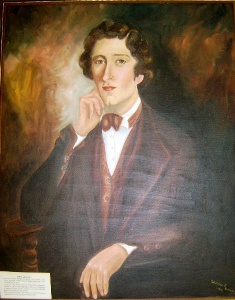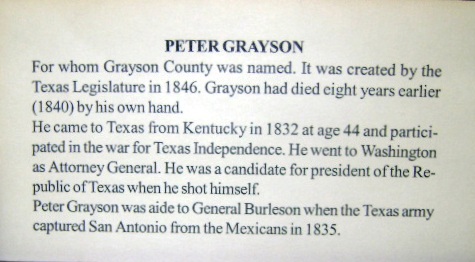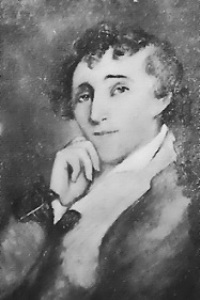|
Peter Wagener Grayson
Sherman Democrat
July 4, 1976 America Always Edition MYSTERY SURROUNDS LIFE, DEATH OF PETER GRAYSON The First Texas Legislature in creating Grayson County gave it the surname of Peter W. Grayson, lone wolf, military leader and ambassador, nineteenth century gentleman who died by his own hand and lies buried in an unmarked grave at Bean Station, Tenn. Peter Grayson, born in 1788 in Bardstown, Kentucky, moved to Austin's colony, Texas in 1830 and settled on a plantation in the area that is now Matagorda County. According to an account of his life prepared by L.W. Kemp of Houston for the Texas Historical Society, Grayson was 44 years old at the time and was a lawyer by profession, a student and a man of culture. At the outbreak of trouble between the Texas colonists and the Mexican government, Grayson became aide to General Edward Burleson. He served during the revolution and assisted in drawing up the treaty with Santa Anna after the Battle of San Jacinto. Independence won, Provisional President, David Burnet made Grayson his attorney general and soon after named him, with James Collingsworth, to go to Washington, D.C., to work for recognition of the republic. When Sam Houston became President, he appointed Grayson first to the attorney general's post and later named him naval agent to the United States. At the time Collingsworth was chief justice of the republic. In July, 1838, Grayson and Collingsworth were two of the four candidates seeking to succeed Sam Houston as president. The campaign was bitter and vituperative. A political observer of the time predicted that Grayson would get few votes, since he was regarded as an administration candidate, and "people are tired of that and of such menas advocate its measures." Having never married, Grayson was referred to as "that old maid" by his political enemies. 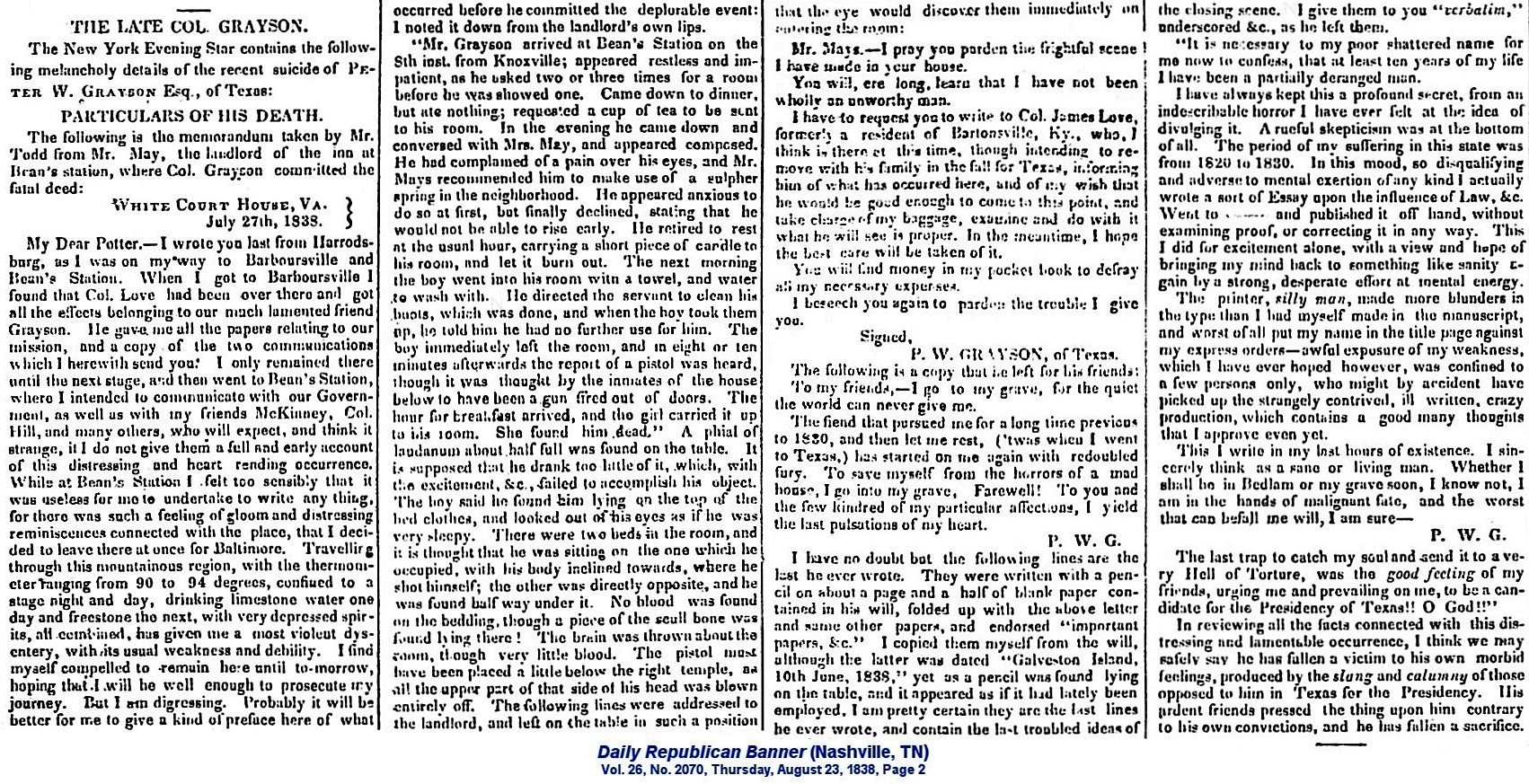 On July 9 at a Bean Station boarding house, Grayson ended his life with a pistol shot through the head. He left a note to the proprietor apologizing for "the frightful scene I have made in your house," and warned that the world would soon know that he was a "wholly unworthy man." 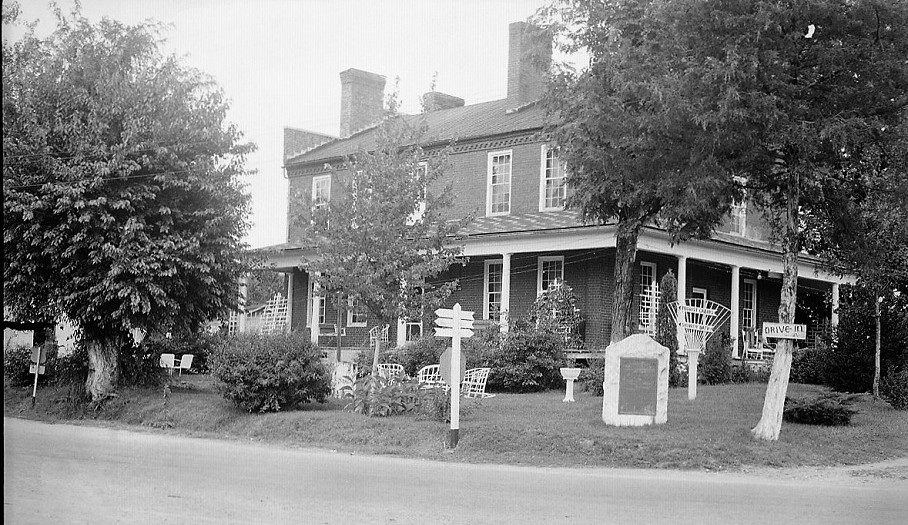 1940s The inn would have been bigger (three stories and 52 rooms) when Grayson died there in 1838. A few days later Grayson's old associate and political rival commited suicide by jumping off a boat in Galveston Bay. What caused the two men to ends their lives so tragically has never been explained, nor has history any mention by his reference to a "wholly unworthy man." The office they both sought was won by Mirabeau B. Lamar. It was at the suggestion of Gov. Pinckney Henderson that the new county created on March 17, 1846 out of a part of Fannin County was named Grayson. In 1978 when the Texas Historical Society became interested in locating and marking graves of Texas heroes, the postmaster at Bean Station answered a query about Grayson's grave by saying that nobody in town had ever heard of the man. His grave was lost WHERE IS PETER GRAYSON? 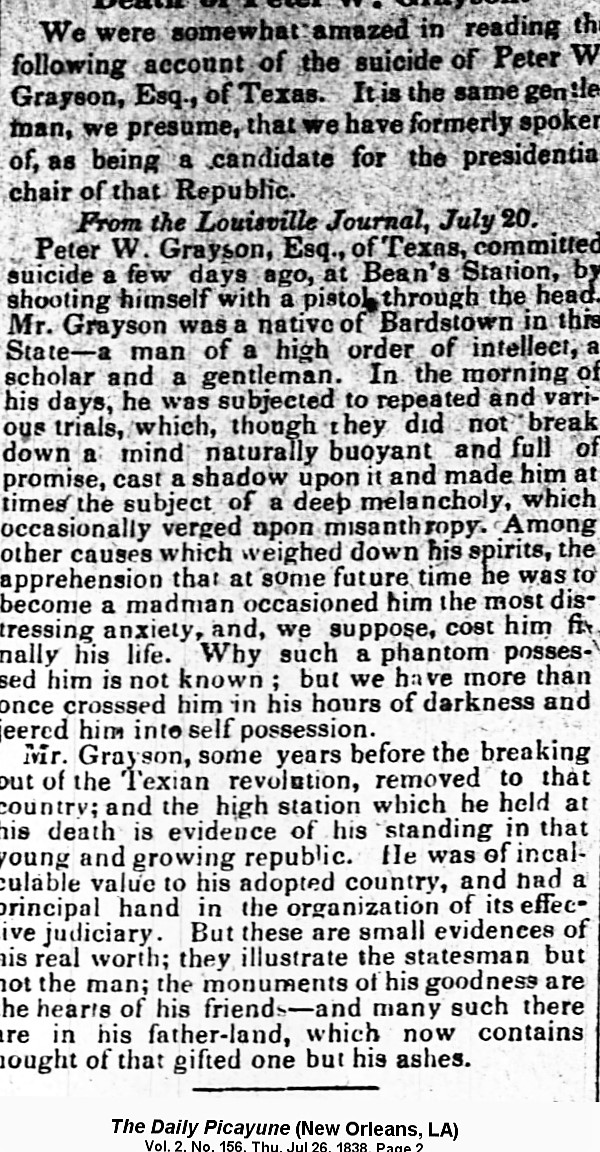 It quotes at length from the July 20 edition of the Louisville Journal, which concludes its eulogy of the dead man with the words ". . . the monuments of his goodness are the hearts of his friends--and many such there are in his father-land, which now contains nought of that gifted one but his ashes." The fatherland referenced by the Journal was the Commonwealth of Kentucky. Grayson was born in Bardstown and lived in Louisville for many years before moving to Texas in 1830. His older brother, Frederick William Spence Grayson (1784-1827), is buried in Louisville. Frederick's widow, Sally Ward Grayson (1788-1880), lived her entire life in the Louisville area. When Frederick died in 1827, she had him buried first in Louisville's City Cemetery. In the early 1840s the city closed that cemetery and directed that all the bodies in it be disinterred and reburied elsewhere. In 1843 or early 1844 Sara Grayson purchased a family plot in the parish cemetery of the Fourth Street Methodist Episcopal Church. Records show that in March of 1844 the body of her husband, Frederick W. S. Grayson, was reburied somewhere in that cemetery, presumably in the family plot that Sarah had recently purchased. The Fourth Street Church incorporated their cemetery in 1854 and renamed it "Eastern Cemetery." If Peter Wagener Grayson's ashes do, in fact, lie somewhere in his fatherland, as the Louisville Journal stated, the most likely location would seem to be in the family plot where his brother is buried in Eastern Cemetery. Grayson lived in Louisville before he went to Texas, and his rejection by a Louisville woman is often cited as a contributing factor to the despondency that resulted in his suicide. His several ties to Louisville point to that city as the most likely place to which his body would have been transported after his death. If he is buried in Eastern Cemetery, he would have had to be first buried somewhere else between the time of his death in 1838 and the opening of that cemetery in 1843. One plausible scenario is that he was buried near his brother in City Cemetery in 1838, then reburied in Eastern Cemetery when his brother was moved there in 1844. That said, no record has yet surfaced to pinpoint where in Kentucky he was buried. Dr. Phil DiBlasi, staff archaeologist at the University of Louisville, has all the surviving burial records for Eastern Cemetery. He has written me that the records do not mention Peter W. Grayson. That does not necessarily mean he's not there. Multiple burials in thousands of plots have been discovered as far back as 1858. A whistleblower exposed scandalous practices at the cemetery in 1989, and the story was national news.  Historical Marker Transcription Peter Wagener Grayson Strangers To Us All ~ Lawyers & Poetry  Grayson County History Susan Hawkins © 2024 If you find any of Grayson County TXGenWeb links inoperable, please send me a message. |
